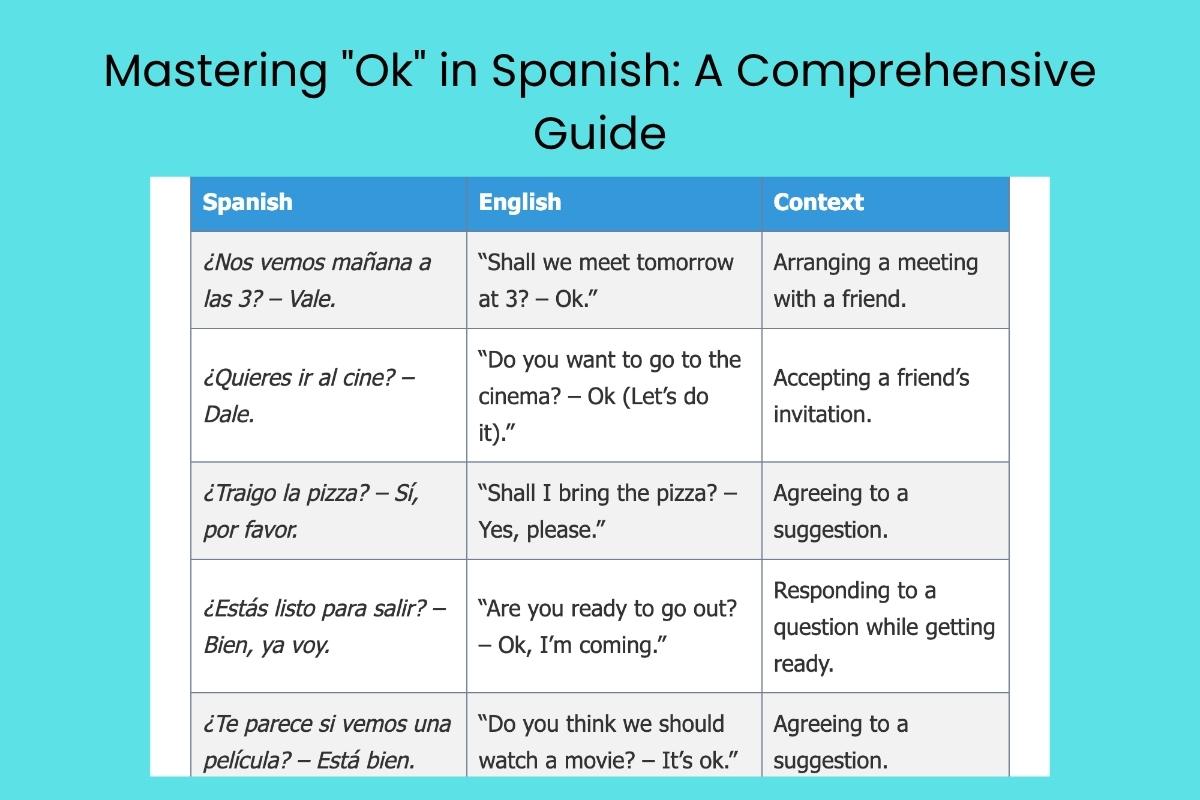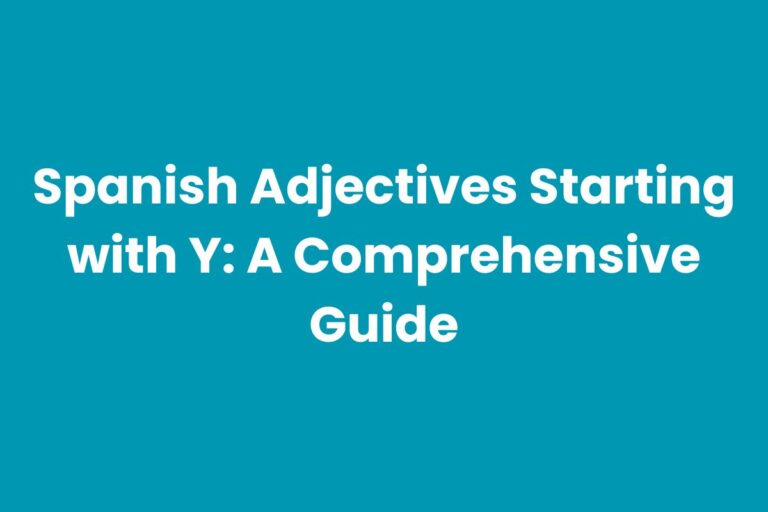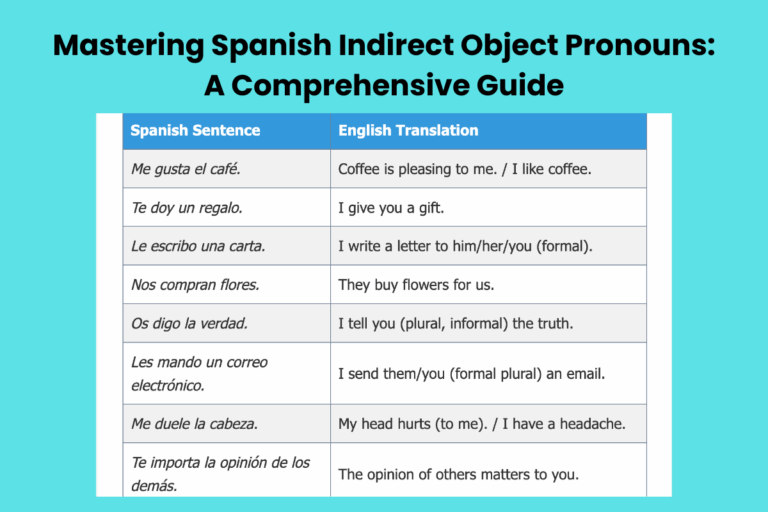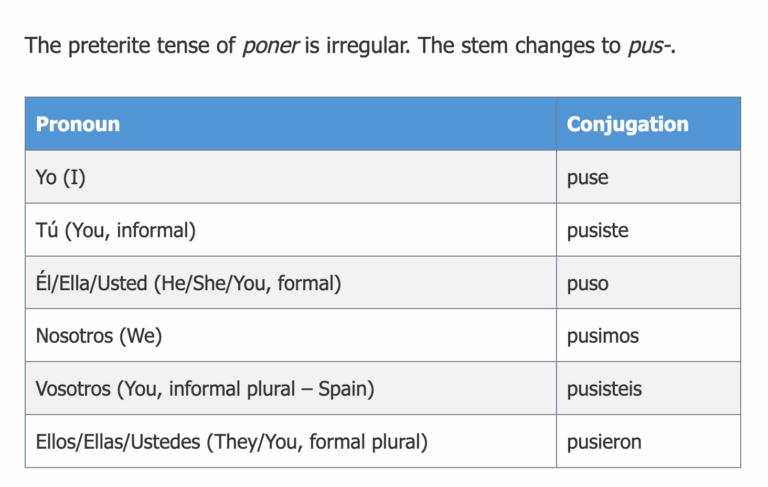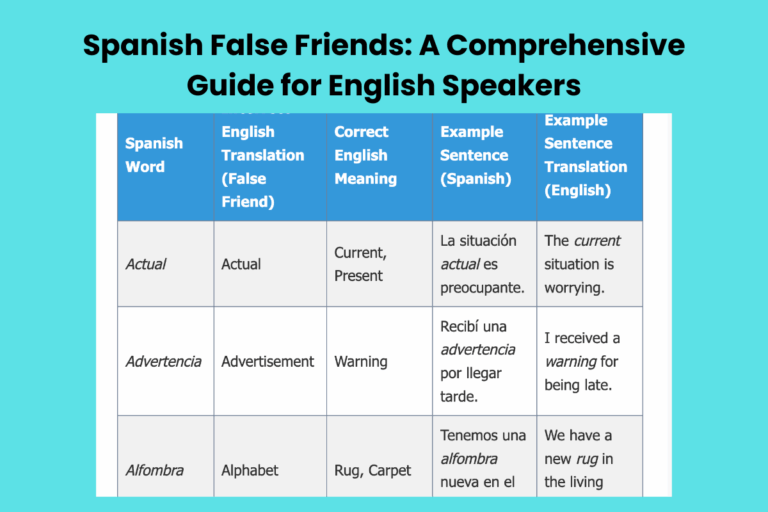Mastering “Ok” in Spanish: A Comprehensive Guide
Understanding how to say “ok” in Spanish is crucial for effective communication in any Spanish-speaking environment. While “ok” itself is sometimes used, knowing the appropriate Spanish alternatives allows you to express agreement, acceptance, or understanding in a more natural and nuanced way.
This guide is designed for learners of all levels, from beginners to advanced students, who want to expand their vocabulary and improve their conversational Spanish. Whether you’re planning a trip to a Spanish-speaking country, communicating with Spanish-speaking colleagues, or simply expanding your language skills, this comprehensive guide will provide you with the knowledge and practice you need.
By exploring various translations and their specific contexts, you’ll gain a deeper understanding of how to use them correctly and confidently. This guide offers a structured approach with definitions, examples, usage rules, and practice exercises to help you master this essential aspect of Spanish communication.
Table of Contents
- Introduction
- Definition of “Ok” in Spanish
- Structural Breakdown
- Types and Categories of “Ok” in Spanish
- Examples in Context
- Usage Rules
- Common Mistakes
- Practice Exercises
- Advanced Topics
- FAQ
- Conclusion
Definition of “Ok” in Spanish
The English word “ok” is a versatile term used to express agreement, acceptance, understanding, or confirmation. In Spanish, there isn’t a single, direct translation that covers all these nuances.
Instead, Spanish offers a variety of alternatives, each with its own specific connotation and context. Choosing the right word or phrase depends on what you want to convey and the situation you’re in.
The purpose of understanding these variations is to communicate effectively and appropriately in Spanish.
The function of these translations is to signal agreement, acceptance, understanding, confirmation, or acknowledgment. They serve as verbal cues that show you are following the conversation and responding appropriately. The contexts in which these words are used vary widely, from formal business settings to casual conversations with friends. For example, “de acuerdo” might be more suitable in a formal context, while “vale” is common in Spain in informal settings. Understanding these contextual differences is essential for mastering the art of saying “ok” in Spanish.
Structural Breakdown
The structural breakdown of expressing “ok” in Spanish involves understanding the different grammatical categories each word or phrase belongs to. Some are adverbs, others are adjectives, and some are complete phrases. For example, “sí” is an adverb, “bien” can be an adverb or an adjective, and “está bien” is a complete phrase using the verb “estar.”
The patterns of usage also vary. Single-word responses like “vale” or “ok” are often used in casual conversations. Phrases like “de acuerdo” or “está bien” are more formal and can be used in a wider range of situations. Compound sentences might include these words to show agreement with a previous statement. For example, “Sí, estoy de acuerdo contigo” (Yes, I agree with you). Understanding these structural elements allows you to use these expressions correctly and naturally.
Types and Categories of “Ok” in Spanish
Spanish offers several ways to say “ok,” each with its own nuance and context. Here’s a breakdown of the most common options:
Sí
“Sí” simply means “yes.” It’s the most basic way to express agreement or affirmation. While it doesn’t directly translate to “ok,” it can often be used in similar contexts.
Vale
“Vale” is a common expression in Spain that is equivalent to “ok” or “alright.” It’s versatile and can be used in a variety of situations. It’s often used to show agreement, acceptance, or understanding.
De acuerdo
“De acuerdo” means “agreed” or “in agreement.” It’s more formal than “vale” and is suitable for business settings or situations where you want to show respect.
Bien
“Bien” means “good” or “well.” It can be used to express agreement or satisfaction. It can also be used to indicate that something is acceptable or satisfactory.
Está bien
“Está bien” means “it’s okay” or “it’s alright.” It’s used to indicate that something is acceptable or that you’re okay with something. It can also be used to reassure someone.
Ok
The English word “ok” is widely used and understood in Spanish, especially in informal settings. However, relying solely on “ok” might make you sound less fluent.
It is important to use with caution in formal settings.
Perfecto
“Perfecto” means “perfect.” It’s used to express strong agreement or satisfaction. It indicates that something is exactly as it should be.
Entendido
“Entendido” means “understood.” It’s used to confirm that you have understood something, especially instructions or information.
Claro
“Claro” means “clear” or “of course.” It can be used to express understanding or agreement. It often implies that something is obvious or easily understood.
Dale
“Dale” is an informal expression, primarily used in Latin America, that means “okay,” “go ahead,” or “let’s do it.” It’s versatile and can be used to express agreement, encouragement, or acceptance.
Examples in Context
The following tables provide examples of how to use these different expressions in context. Each table focuses on a specific scenario to illustrate the appropriate usage.
The first table focuses on casual conversations. These examples show how “ok” can be expressed in everyday situations with friends and family.
| Spanish | English | Context |
|---|---|---|
| ¿Nos vemos mañana a las 3? – Vale. | “Shall we meet tomorrow at 3? – Ok.” | Arranging a meeting with a friend. |
| ¿Quieres ir al cine? – Dale. | “Do you want to go to the cinema? – Ok (Let’s do it).” | Accepting a friend’s invitation. |
| ¿Traigo la pizza? – Sí, por favor. | “Shall I bring the pizza? – Yes, please.” | Agreeing to a suggestion. |
| ¿Estás listo para salir? – Bien, ya voy. | “Are you ready to go out? – Ok, I’m coming.” | Responding to a question while getting ready. |
| ¿Te parece si vemos una película? – Está bien. | “Do you think we should watch a movie? – It’s ok.” | Agreeing to a suggestion. |
| ¿Puedes ayudarme con esto? – Ok. | “Can you help me with this? – Ok.” | Agreeing to help someone. |
| ¿Hacemos una pausa? – Perfecto. | “Shall we take a break? – Perfect.” | Expressing strong agreement. |
| ¿Me entendiste? – Entendido. | “Did you understand me? – Understood.” | Confirming understanding. |
| ¿Debemos irnos ahora? – Claro. | “Should we leave now? – Of course.” | Expressing agreement. |
| ¿Te encargo el café? – Dale. | “Shall I order the coffee for you? – Ok (Go ahead).” | Accepting an offer. |
| ¿Podemos usar tu coche? – Vale, pero ten cuidado. | “Can we use your car? – Ok, but be careful.” | Granting permission with a condition. |
| Tenemos que terminar esto hoy. – De acuerdo. | “We have to finish this today. – Agreed.” | Showing agreement on a task. |
| ¿Te gusta esta canción? – Bien, me gusta mucho. | “Do you like this song? – Ok, I like it a lot.” | Expressing liking something. |
| ¿Está todo en orden? – Está bien, gracias. | “Is everything in order? – It’s ok, thank you.” | Confirming that everything is fine. |
| ¿Ya compraste los boletos? – Ok, ya los tengo. | “Did you already buy the tickets? – Ok, I have them already.” | Confirming that a task is completed. |
| ¿Nos vemos en el parque? – Perfecto, ahí estaré. | “Shall we meet at the park? – Perfect, I’ll be there.” | Expressing agreement and enthusiasm. |
| ¿Recibiste el correo? – Entendido, lo revisaré. | “Did you receive the email? – Understood, I’ll check it.” | Confirming receipt and intention to act. |
| ¿Estás de acuerdo con mi plan? – Claro, me parece genial. | “Do you agree with my plan? – Of course, I think it’s great.” | Expressing agreement and approval. |
| ¿Te llevo al aeropuerto? – Dale, muchas gracias. | “Shall I take you to the airport? – Ok, thank you very much.” | Accepting an offer of a ride. |
| ¿Quieres que te ayude con la tarea? – Sí, por favor. | “Do you want me to help you with the homework? – Yes, please.” | Accepting an offer of help. |
| ¿Regresamos a casa? – Vale, estoy cansado. | “Shall we go back home? – Ok, I’m tired.” | Agreeing to go home. |
| ¿Nos vemos el fin de semana? – De acuerdo, me parece bien. | “Shall we meet on the weekend? – Agreed, that sounds good.” | Making plans for the weekend. |
| ¿Te sirvo más agua? – Bien, gracias. | “Shall I pour you more water? – Ok, thank you.” | Accepting an offer of more water. |
| ¿Llevamos paraguas? – Está bien, por si acaso. | “Shall we take umbrellas? – It’s ok, just in case.” | Agreeing to take umbrellas as a precaution. |
| ¿Revisaste el informe? – Ok, ya lo revisé. | “Did you check the report? – Ok, I already checked it.” | Confirming that the report has been checked. |
| ¿Estás listo para empezar? – Perfecto, estoy listo. | “Are you ready to start? – Perfect, I’m ready.” | Expressing readiness to start. |
| ¿Comprendes el problema? – Entendido, sé cómo solucionarlo. | “Do you understand the problem? – Understood, I know how to solve it.” | Confirming understanding of the problem. |
| ¿Podemos confiar en él? – Claro, es una persona honesta. | “Can we trust him? – Of course, he’s an honest person.” | Expressing confidence in someone. |
| ¿Te parece bien este horario? – Dale, me acomoda perfecto. | “Does this schedule work for you? – Ok, it fits me perfectly.” | Confirming that the schedule works. |
The following table focuses on formal situations. These examples demonstrate how to use “ok” equivalents in professional settings, such as meetings or business negotiations.
| Spanish | English | Context |
|---|---|---|
| ¿Está de acuerdo con los términos del contrato? – De acuerdo. | “Do you agree with the terms of the contract? – Agreed.” | Formally agreeing to contract terms. |
| ¿Acepta la propuesta? – Sí, acepto. | “Do you accept the proposal? – Yes, I accept.” | Accepting a formal proposal. |
| ¿Entendió las instrucciones? – Entendido. | “Did you understand the instructions? – Understood.” | Confirming understanding of instructions. |
| ¿Podemos proceder? – Claro, proceda. | “Can we proceed? – Of course, proceed.” | Giving permission to proceed. |
| ¿Está todo claro? – Está bien, todo está claro. | “Is everything clear? – It’s ok, everything is clear.” | Confirming clarity. |
| ¿Confirmamos la reunión? – Perfecto, confirmada. | “Shall we confirm the meeting? – Perfect, confirmed.” | Confirming a meeting. |
| ¿Aprobamos el presupuesto? – Bien, aprobado. | “Shall we approve the budget? – Ok, approved.” | Approving a budget. |
| ¿Debemos firmar aquí? – Sí, aquí debe firmar. | “Should we sign here? – Yes, you should sign here.” | Indicating where to sign. |
| ¿Le parece bien este plan? – De acuerdo, me parece un buen plan. | “Does this plan seem good to you? – Agreed, it seems like a good plan.” | Expressing agreement with a plan. |
| ¿Podemos contar con su apoyo? – Claro, pueden contar con mi apoyo. | “Can we count on your support? – Of course, you can count on my support.” | Offering support. |
| ¿Es suficiente esta información? – Sí, es suficiente. | “Is this information sufficient? – Yes, it is sufficient.” | Confirming that the information is sufficient. |
| ¿Está conforme con el resultado? – Bien, estoy conforme. | “Are you satisfied with the result? – Ok, I am satisfied.” | Expressing satisfaction with the result. |
| ¿Acepta las condiciones? – De acuerdo, acepto las condiciones. | “Do you accept the conditions? – Agreed, I accept the conditions.” | Formally accepting conditions. |
| ¿Ha revisado el informe? – Entendido, ya lo he revisado. | “Have you reviewed the report? – Understood, I have already reviewed it.” | Confirming that the report has been reviewed. |
| ¿Le parece correcto este enfoque? – Claro, me parece correcto. | “Does this approach seem correct to you? – Of course, it seems correct.” | Expressing agreement with the approach. |
| ¿Podemos confiar en este proveedor? – Sí, podemos confiar en él. | “Can we trust this supplier? – Yes, we can trust him.” | Expressing confidence in a supplier. |
| ¿Está seguro de su decisión? – Perfecto, estoy seguro. | “Are you sure of your decision? – Perfect, I am sure.” | Expressing certainty about a decision. |
| ¿Debemos notificar al cliente? – Sí, debemos notificarlo. | “Should we notify the client? – Yes, we should notify him.” | Agreeing to notify the client. |
| ¿Comenzamos la presentación? – Claro, comencemos. | “Shall we start the presentation? – Of course, let’s start.” | Agreeing to start the presentation. |
| ¿Está de acuerdo con el calendario? – De acuerdo, me parece bien. | “Do you agree with the schedule? – Agreed, it seems good to me.” | Expressing agreement with the schedule. |
| ¿Confirma su asistencia? – Sí, confirmo mi asistencia. | “Do you confirm your attendance? – Yes, I confirm my attendance.” | Confirming attendance. |
| ¿Está satisfecho con el progreso? – Bien, estoy satisfecho con el progreso. | “Are you satisfied with the progress? – Ok, I am satisfied with the progress.” | Expressing satisfaction with the progress. |
| ¿Entendió los requisitos? – Entendido, entiendo los requisitos. | “Did you understand the requirements? – Understood, I understand the requirements.” | Confirming understanding of the requirements. |
| ¿Podemos implementar este cambio? – Claro, podemos implementarlo. | “Can we implement this change? – Of course, we can implement it.” | Agreeing to implement the change. |
| ¿Está conforme con la solución? – Perfecto, estoy conforme con la solución. | “Are you satisfied with the solution? – Perfect, I am satisfied with the solution.” | Expressing satisfaction with the solution. |
| ¿Autoriza la compra? – Sí, autorizo la compra. | “Do you authorize the purchase? – Yes, I authorize the purchase.” | Authorizing a purchase. |
| ¿Debemos informar a la gerencia? – Sí, debemos informarlos. | “Should we inform the management? – Yes, we should inform them.” | Agreeing to inform management. |
| ¿Podemos programar otra reunión? – Claro, podemos programarla. | “Can we schedule another meeting? – Of course, we can schedule it.” | Agreeing to schedule another meeting. |
This final table focuses on situations where you want to express understanding or acknowledgment. These examples show how to confirm that you have understood what someone has said or instructed.
| Spanish | English | Context |
|---|---|---|
| Necesitas entregar el informe mañana. – Entendido. | “You need to submit the report tomorrow. – Understood.” | Confirming you understood the deadline. |
| Recuerda llamar al cliente. – Claro, lo haré. | “Remember to call the client. – Of course, I will.” | Acknowledging a reminder. |
| No olvides cerrar la puerta. – Vale, no se me olvidará. | “Don’t forget to close the door. – Ok, I won’t forget.” | Acknowledging a reminder. |
| Debes revisar estos documentos. – Sí, los revisaré. | “You must review these documents. – Yes, I will review them.” | Acknowledging a task. |
| Tienes que estar aquí a las 9. – Está bien, llegaré a tiempo. | “You have to be here at 9. – It’s ok, I’ll arrive on time.” | Confirming you will be on time. |
| No debes usar este programa sin permiso. – Entendido. | “You must not use this program without permission. – Understood.” | Acknowledging a restriction. |
| Recuerda apagar las luces. – Claro, las apagaré. | “Remember to turn off the lights. – Of course, I will turn them off.” | Acknowledging a reminder. |
| Debes completar este formulario. – Sí, lo completaré. | “You must complete this form. – Yes, I will complete it.” | Acknowledging a task. |
| Tienes que revisar el contrato. – Está bien, lo revisaré. | “You have to review the contract. – It’s ok, I will review it.” | Acknowledging a task. |
| No olvides llevar tu identificación. – Vale, la llevaré. | “Don’t forget to bring your ID. – Ok, I will bring it.” | Acknowledging a reminder. |
| Debes confirmar tu asistencia. – Sí, la confirmaré. | “You must confirm your attendance. – Yes, I will confirm it.” | Acknowledging a task. |
| Tienes que seguir estas instrucciones. – Está bien, las seguiré. | “You have to follow these instructions. – It’s ok, I will follow them.” | Acknowledging instructions. |
| No debes llegar tarde. – Entendido. | “You must not arrive late. – Understood.” | Acknowledging a warning. |
| Recuerda enviar el correo. – Claro, lo enviaré. | “Remember to send the email. – Of course, I will send it.” | Acknowledging a reminder. |
| Debes limpiar tu habitación. – Sí, la limpiaré. | “You must clean your room. – Yes, I will clean it.” | Acknowledging a task. |
| Tienes que hacer la tarea. – Está bien, la haré. | “You have to do the homework. – It’s ok, I will do it.” | Acknowledging a task. |
| No olvides comprar pan. – Vale, no lo olvidaré. | “Don’t forget to buy bread. – Ok, I won’t forget it.” | Acknowledging a reminder. |
| Debes leer este libro. – Sí, lo leeré. | “You must read this book. – Yes, I will read it.” | Acknowledging a task. |
| Tienes que regar las plantas. – Está bien, las regaré. | “You have to water the plants. – It’s ok, I will water them.” | Acknowledging a task. |
| No debes hablar en clase. – Entendido. | “You must not talk in class. – Understood.” | Acknowledging a rule. |
| Recuerda estudiar para el examen. – Claro, estudiaré. | “Remember to study for the exam. – Of course, I will study.” | Acknowledging a reminder. |
| Debes lavar los platos. – Sí, los lavaré. | “You must wash the dishes. – Yes, I will wash them.” | Acknowledging a task. |
| Tienes que cuidar al perro. – Está bien, lo cuidaré. | “You have to take care of the dog. – It’s ok, I will take care of it.” | Acknowledging a task. |
| No olvides cerrar las ventanas. – Vale, no las olvidaré. | “Don’t forget to close the windows. – Ok, I won’t forget them.” | Acknowledging a reminder. |
| Debes practicar español. – Sí, practicaré. | “You must practice Spanish. – Yes, I will practice.” | Acknowledging a task. |
| Tienes que ser puntual. – Está bien, seré puntual. | “You have to be punctual. – It’s ok, I will be punctual.” | Acknowledging a requirement. |
| Recuerda pagar la factura. – Claro, la pagaré. | “Remember to pay the bill. – Of course, I will pay it.” | Acknowledging a reminder. |
| Debes ser respetuoso. – Sí, lo seré. | “You must be respectful. – Yes, I will be.” | Acknowledging a requirement. |
| Tienes que ser honesto. – Está bien, lo seré. | “You have to be honest. – It’s ok, I will be.” | Acknowledging a requirement. |
Usage Rules
The usage rules for saying “ok” in Spanish depend on the context, region, and level of formality. Here’s a breakdown of the key rules:
- Formality: In formal situations, prefer “de acuerdo” or “sí,” especially in business settings. In informal settings, “vale,” “está bien,” “bien,” “ok,” or “dale” are acceptable.
- Region: “Vale” is primarily used in Spain. “Dale” is more common in Latin America. Other expressions like “de acuerdo,” “sí,” “está bien,” and “bien” are widely understood across Spanish-speaking regions.
- Nuance: “Perfecto” expresses strong agreement or satisfaction. “Entendido” confirms understanding. “Claro” implies that something is obvious or easily understood.
- Agreement: “Sí” is a simple affirmation. “De acuerdo” shows formal agreement with a proposal or statement.
- Acceptance: “Está bien” indicates that something is acceptable. “Vale” can also be used to accept a suggestion or offer.
- Understanding: “Entendido” confirms that you have understood something. “Claro” can also imply understanding.
There are no strict exceptions to these rules, but context always matters. Pay attention to how native speakers use these expressions and adapt accordingly.
Common Mistakes
One common mistake is using “ok” excessively, which can make you sound less fluent. While it’s understood, it’s better to use the appropriate Spanish alternatives. Another mistake is using “vale” in Latin America, where it’s not as common. Using formal expressions like “de acuerdo” in very casual settings can also sound unnatural.
Here are some examples of common mistakes and their corrections:
| Incorrect | Correct | Explanation |
|---|---|---|
| Ok, voy a la tienda. | Vale, voy a la tienda. (Spain) / Dale, voy a la tienda. (Latin America) | Using “ok” instead of the regional equivalent. |
| De acuerdo, ¿vamos a tomar un café? | ¿Vale?, ¿vamos a tomar un café? (Spain) / ¿Dale?, ¿vamos a tomar un café? (Latin America) | Using a formal expression in a casual context. |
| Sí, estoy de acuerdo en todo. | Sí, estoy de acuerdo con todo. | Incorrect preposition usage (en instead of con). |
| Está bien, pero no me gusta. | Está bien, pero no me gusta. | No mistake, but rephrasing to ‘De acuerdo, pero no me gusta’ could add more emphasis. |
| Entendido, no lo hago. | Entendido, no lo haré. | Incorrect verb tense (present instead of future). |
| Claro, pero necesito ayuda. | Claro, pero necesito ayuda. | No mistake, but rephrasing to ‘Por supuesto, pero necesito ayuda’ could sound more natural. |
| Perfecto, voy a la fiesta. | Perfecto, iré a la fiesta. | Using the correct verb tense (present instead of future). |
| Entendido, lo hago mañana. | Entendido, lo haré mañana. | Using the correct verb tense (present instead of future). |
| Claro, te ayudo ahora. | Claro, te ayudaré ahora. | Using the correct verb tense (present instead of future). |
| Perfecto, lo termino hoy. | Perfecto, lo terminaré hoy. | Using the correct verb tense (present instead of future). |
Practice Exercises
Complete the following sentences with the appropriate Spanish equivalent of “ok.” Choose from “sí,” “vale,” “de acuerdo,” “bien,” “está bien,” “ok,” “perfecto,” “entendido,” “claro,” or “dale.”
| Question | Answer |
|---|---|
| ¿Nos vemos mañana a las 10? – ________ | Vale / De acuerdo |
| ¿Quieres venir a mi casa? – ________ | Dale |
| ¿Entendiste la lección? – ________ | Entendido |
| ¿Podemos usar tu coche? – ________ | Está bien |
| ¿Estás de acuerdo con mi plan? – ________ | De acuerdo |
| ¿Necesitas ayuda? – ________ | Sí |
| ¿Está todo listo? – ________ | Bien |
| ¿Confirmamos la cita? – ________ | Perfecto |
| ¿Debemos irnos ahora? – ________ | Claro |
| ¿Te parece bien este horario? – ________ | Ok |
| ¿Quieres ir al cine esta noche? – ________ | Dale |
| ¿Comprendes el problema? – ________ | Entendido |
| ¿Podemos confiar en él? – ________ | Claro |
| ¿Está todo en orden? – ________ | Está bien |
| ¿Aceptas la propuesta? – ________ | De acuerdo |
| ¿Es
suficiente esta información? – ________ |
Sí |
| ¿Comenzamos la presentación? – ________ | Claro |
| ¿Está satisfecho con el progreso? – ________ | Bien |
| ¿Debemos notificar al cliente? – ________ | Sí |
| ¿Podemos contar con tu apoyo? – ________ | Claro |
Advanced Topics
To further refine your understanding, consider these advanced topics:
- Regional Variations: Explore how different Spanish-speaking countries use unique expressions or variations of the common ones. For example, in some regions, you might hear “Okey” or localized slang.
- Idiomatic Expressions: Learn idiomatic expressions that convey agreement or understanding. For example, “¡Hecho!” (Done!) is a strong way to express agreement.
- Cultural Context: Understand the cultural nuances of communication. In some cultures, direct agreement is preferred, while in others, more subtle forms of acknowledgment are common.
FAQ
Conclusion
Mastering how to say “ok” in Spanish involves understanding the nuances of different expressions and their appropriate contexts. By using the right word or phrase, you can communicate more effectively and confidently in Spanish. Whether you choose “sí,” “vale,” “de acuerdo,” or another alternative, remember to consider the formality, region, and specific meaning you want to convey. With practice and attention to detail, you’ll be well-equipped to navigate any conversation with ease.

